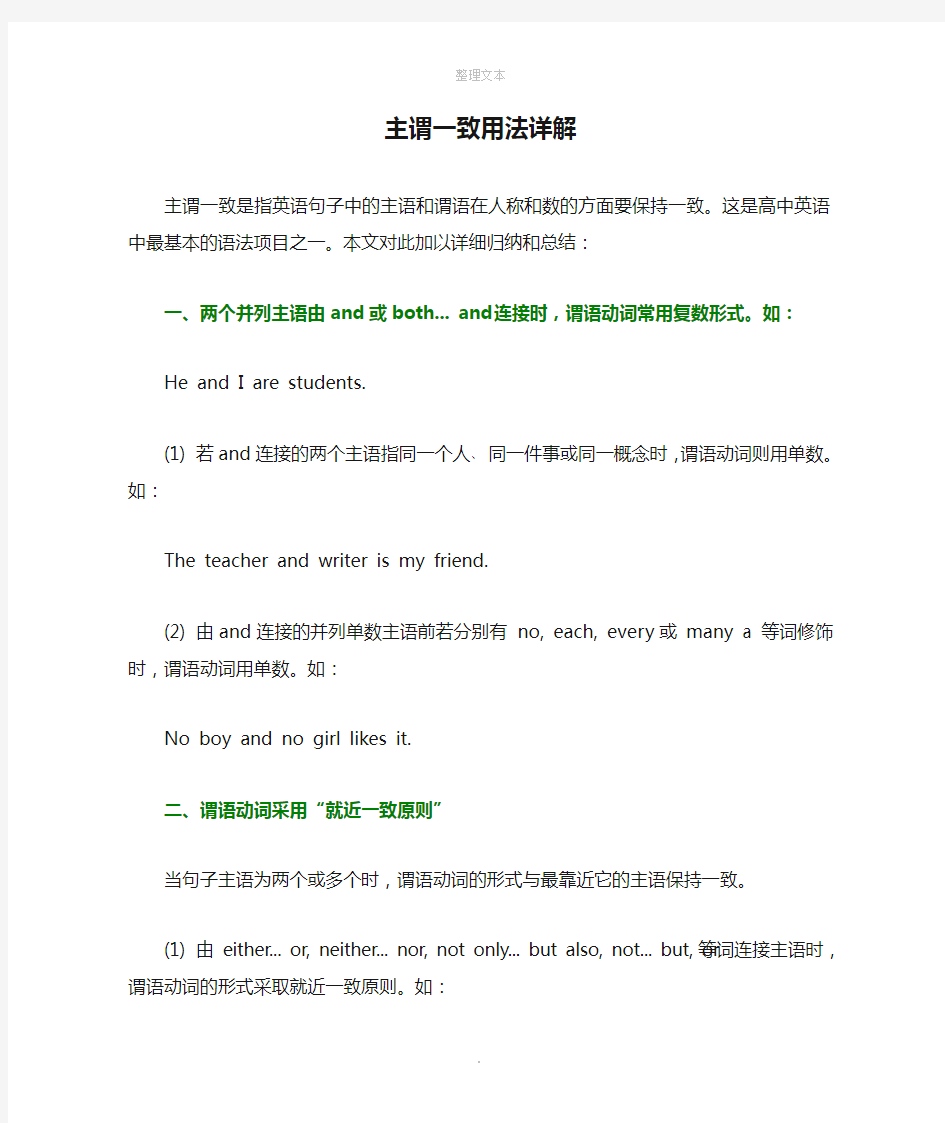

主谓一致用法详解
主谓一致是指英语句子中的主语和谓语在人称和数的方面要保持一致。这是高中英语中最基本的语法项目之一。本文对此加以详细归纳和总结:
一、两个并列主语由and或both... and连接时,谓语动词常用复数形式。如:
He and I are students.
(1) 若and连接的两个主语指同一个人﹑同一件事或同一概念时,谓语动词则用单数。如:
The teacher and writer is my friend.
(2) 由and连接的并列单数主语前若分别有no, each, every或many a 等词修饰时,谓语动词用单数。如:
No boy and no girl likes it.
二、谓语动词采用“就近一致原则”
当句子主语为两个或多个时,谓语动词的形式与最靠近它的主语保持一致。
(1) 由either... or, neither... nor, not only... but also, not... but, or等词连接主语时,谓语动词的形式采取就近一致原则。如:
Not you but I am to answer the question.
(2) a lot of, lots of, plenty of, most of, dozens of, scores of, hundreds of 等词后接名词作句子主语时,谓语动词的形式与靠近它的名词保持一致。如:
Plenty of money has been wasted.
Most of people are from Australia.
(3) There / here be... 句型中,谓语动词的形式与靠近它的主语保持一致。如:
There is an apple and two oranges on the plate.
(4) 分数或百分数后接名词作句子主语时,谓语动词的形式与靠近它的主语保持一致。如:
More than 30 percent of the surface is covered by the water.
三、谓语动词采用“就前一致原则”
当句子主语里含有如下短语接名词时,谓语动词的形式与前面的主语保持一致。
as well as, rather than, but, besides, except, like, including, with, together with, along with, as much as, in addition to。如:
A teacher with some students is doing experiments in the lab.
He, like his two brothers, is very clever.
四、谓语动词只采用单数形式
(1)表单数意义的不定代词作主语时,谓语动词用单数形式。如everything, everyone, everybody, nothing, nobody, something, someone, somebody, anything, anyone, anybody, either, neither, each, one, the other, another等。如:
Everything is ready.
(2) 动名词﹑动词不定式或从句作主语时,谓语动词用单数形式。如:
Watching a family of chimps wake up is our first activity of the day.
To walk with him is a pleasure.
What he says makes me puzzled.
(3) many a接单数名词作主语或more than one接单数名词作主语时,谓语用单数形式。如:
More than one student stays in the classroom.
(4) 表示学科的名词作句子的主语时,谓语动词用单数。如:Physics is taught in my school.
(5) 当表示“时间﹑数目﹑距离﹑价格﹑金钱”的名词作主语时,谓语动词常用单数形式。
(6) 表示名称的专有名称作句子的主语时,谓语动词用单数形式。如:Beijing is the capital of our country.
五、谓语动词用单数或复数要看主语所表达的意义。
1. 集体名词如class, family, team, group, government, audience, crowd, company, crew, public等作主语时:
(1) 若强调整体时,谓语动词形式用单数。如:
The government is planning further cuts in income tax.
(2) 若强调组成该集体的分散个体时,谓语动词常用复数。如:
The government were having a meeting when I got there.
(3) 有些名词本身表示复数概念,谓语动词要用复数形式。如:People are talking about the news.
2. 表示成双成对的名词,如trousers, shoes, glasses, compasses等作主语
时:
(1)如这类词本身作主语,谓语动词用复数。
Your black trousers are too long.
(2) 若这类名词前有a pair of / a kind of / a type of 等修饰时,谓语动词用单数。
This pair of shoes is mine.
3. “定冠词+ 形容词或分词”作主语时:
(1) 若表示一类人时,谓语动词用复数。
The old are taken good care of in my country.
(2) 若表示一件事或一类抽象概念时,谓语动词用单数。
The beautiful gives pleasure to all.
4. 定语从句中关系代词在从句中作主语时,从句谓语动词的数要与先行词的数保持一致。
The building which stands near the river is our school.
(1) 当先行词为“one of + 名词复数”时,从句谓语动词用复数形式。He was one of the boys who were to blame.
(2) 当先行词为“the only one of + 名词复数)”时,从句谓语动词用单数形式。
He was the only one of the boys who was to blame.